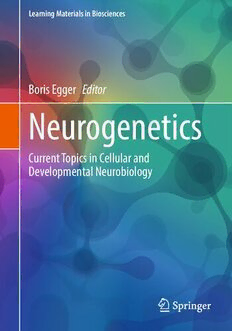
Neurogenetics: Current Topics in Cellular and Developmental Neurobiology PDF
Preview Neurogenetics: Current Topics in Cellular and Developmental Neurobiology
Learning Materials in Biosciences Boris Egger Editor Neurogenetics Current Topics in Cellular and Developmental Neurobiology Learning Materials in Biosciences SeriesEditors AnjaK.Bosserhoff,Friedrich-AlexanderUniversityErlangen-,Erlangen,Germany AydinBerenjian,TheUniversityofWaikato,Hamilton,Waikato,NewZealand PabloCarbonell,UniversitatPolitècnicadeValència,Valencia,Spain Mia Levite,Schoolof Pharmacy,Faculty of Medicine,Hebrew Universityof Jerusalem, Jerusalem,Israel JoanRoig,MolecularBiologyInstituteofBarcelona,Barcelona,Spain KursadTurksen,UniversityofOttawa,Ottawa,ON,Canada Learning Materials in Biosciences textbookscompactly and concisely discuss a specific biological,biomedical,biochemical,bioengineeringorcellbiologictopic.Thetextbooks inthisseriesarebasedonlecturesforupper-levelundergraduates,master’sandgraduate students,presentedandwrittenbyauthoritativefiguresinthefieldatleadinguniversities aroundtheglobe. Thetitlesareorganizedto guidethereaderto adeeperunderstandingoftheconcepts covered. Eachtextbookprovidesreaderswithfundamentalinsightsintothesubjectandprepares themtoindependentlypursuefurtherthinkingandresearchonthetopic.Coloredfigures, step-by-stepprotocolsand take-homemessages offeran accessible approachto learning andunderstanding. In addition to being designed to benefit students, Learning Materials textbooks represent a valuable tool for lecturers and teachers, helping them to prepare their own respectivecoursework. Boris Egger Editor Neurogenetics Current Topics in Cellular and Developmental Neurobiology Editor BorisEgger DepartmentofBiology UniversityofFribourg Fribourg,Switzerland ISSN2509-6125 ISSN2509-6133 (electronic) LearningMaterialsinBiosciences ISBN978-3-031-07792-0 ISBN978-3-031-07793-7 (eBook) https://doi.org/10.1007/978-3-031-07793-7 ©SpringerNatureSwitzerlandAG2023 This work is subject to copyright. All rights are reserved by the Publisher, whether the whole or part of the material is concerned, specifically the rights of translation, reprinting, reuse of illustrations, recitation, broadcasting,reproductiononmicrofilmsorinanyotherphysicalway,andtransmissionorinformationstorage andretrieval,electronicadaptation,computersoftware,orbysimilarordissimilarmethodologynowknownor hereafterdeveloped. Theuseofgeneraldescriptivenames,registerednames,trademarks,servicemarks,etc.inthispublicationdoes notimply,evenintheabsenceofaspecificstatement,thatsuchnamesareexemptfromtherelevantprotective lawsandregulationsandthereforefreeforgeneraluse. Thepublisher,theauthors,andtheeditorsaresafetoassumethattheadviceandinformationinthisbookare believedtobetrueandaccurateatthedateofpublication. Neitherthepublishernortheauthorsortheeditors giveawarranty,expressedorimplied,withrespecttothematerialcontainedhereinorforanyerrorsoromissions thatmayhavebeenmade.Thepublisherremainsneutralwithregardtojurisdictionalclaimsinpublishedmaps andinstitutionalaffiliations. ThisSpringerimprintispublishedbytheregisteredcompanySpringerNatureSwitzerlandAG Theregisteredcompanyaddressis:Gewerbestrasse11,6330Cham,Switzerland Preface Thiscollectionofchaptersaimstoaccompanyalectureseriesinneurogenetics.Itprovides a framework for the discipline that seeks to analyze the relations between the genome, neurons, neural networks, and behavior. The selection of topics in this book aims to provide students with insights into developmental, cellular, and genetic mechanisms in neurobiology.Aspecialemphasisisgiventoexperimentalanimalmodelsystemssuchas Caenorhabditiselegans, Drosophila melanogaster, and vertebrate models. Each chapter startswithanintroductionandanoverviewofthelecturetopic.Itisfollowedbythemain content,whichincludesboththeoreticalandtechnicalexperimentalparts. Thelectureseriesaddressesstudentswhoaredoingtheirmaster’sanddoctoralthesis work in the field of neurobiology. It should help and inspire students to establish a theoreticalbackground,thinkaboutconceptsanddesigntheirownresearchexperiments. Fribourg,Switzerland BorisEgger v Contents 1 IntroductiontoNeurogenetics................................................... 1 BorisEggerandDominiqueA.Glauser 2 NeurogeneticAnalysisinCaenorhabditiselegans.............................. 13 SaurabhThapliyalandDominiqueA.Glauser 3 RegionalizationoftheEarlyNervousSystem.................................. 47 BorisEgger 4 EarlyNeurogenesisandGliogenesisinDrosophila............................ 71 BorisEgger 5 NeuralStemCellsandBrainTumourModelsinDrosophila ................ 85 BorisEgger 6 EyeDevelopmentinDrosophila:FromPhotoreceptorSpecification toTerminalDifferentiation....................................................... 105 AbhishekKumarMishraandSimonG.Sprecher 7 NeurogeneticsofMemory,Learning,andForgetting......................... 129 LuciadeAndres-Bragado,JeniferC.Kaldun,andSimonG.Sprecher 8 EvolutionandOriginsofNervousSystems .................................... 147 JulesDuruzandSimonG.Sprecher 9 EmbryonicNeurogenesisintheMammalianBrain........................... 165 DotunAdeleyeAdeyinkaandBorisEgger 10 ModelsofNeurodegenerativeDiseases ......................................... 179 NiranMaharjanandSmitaSaxena Index...................................................................................... 211 vii 1 Introduction to Neurogenetics BorisEgger,DominiqueA.Glauser WhatWillYouLearninThisChapter Thisfirstchapterprovidesanoverviewofthefieldofneurogeneticsincluding: (cid:129) Specificdefinitionsandexamplesinordertounderstandthedifferentmeanings thatthetermneurogeneticsmayhaveindifferentfieldsofscience. (cid:129) Abriefhistoryofthefieldofneurogeneticresearch. (cid:129) Acomparativepresentationofthemainneurogeneticexperimentalanimalsand systems,withaspecificfocusonthestrengthsofeachmodel. 1.1 DefinitionsofNeurogenetics Neurogeneticsdealswiththerelationsbetweenthegenomeandthenervoussystem.The termneurogeneticsisusedinatleastthreedifferentways: Instrumentalorappliedneurogeneticsusesmutantsorgenetictechniquesastoolsfor analyzingstructuralorfunctionalaspectsofthenervoussystem.Examplesofthisarethe useofmutantsthatleadtohomeotictransformationsofappendagesorenhancertraplines asneuron-typespecificmarkers. B.Egger((cid:2))·D.A.Glauser((cid:2)) DepartmentofBiology,UniversityofFribourg,Fribourg,Switzerland e-mail:[email protected];[email protected] ©SpringerNatureSwitzerlandAG2023 1 B.Egger(ed.),Neurogenetics,LearningMaterialsinBiosciences, https://doi.org/10.1007/978-3-031-07793-7_1 2 B.EggerandD.A.Glauser Analyticalneurogeneticsattemptstoexplainthemolecularmechanismsofgenesthat affect the nervous system and elucidate their interactions. It tries to understand how far the nervoussystem is genetically programmedand whethertrue “neuralgenes” exist. Is thereevidenceforgeneswhoseactivityisrestrictedtothenervoussystemonly?Analytical neurogeneticsseeks to elucidate the relationsbetweengenes, neurons,neuronalcircuits, andbehavior. Medical neurogenetics investigates the genetic background of human neurogenetic disorders(e.g.,MicrocephalyorAlzheimer’sDisease). 1.2 InstrumentalVersusAnalyticalNeurogenetics The difference between instrumental and analytical neurogenetics is illustrated in the followingexamples: Exampleforinstrumentalneurogenetics: Homeotic mutations in Drosophila result in changes in the identity of specific body segments. For example, a gain-of-function mutation in the gene Antennapedia can lead to an antenna to leg transformation [1]. It raises the question of where sensory neurons fromsuchatransformedappendageprojectinthebrain:totheantennalcentersortothe leg centers? Homeotic mutants, therefore,allow us to analyze how the axonsof sensory neuronsfindtheircorrecttargetsinthebrain. Exampleforanalyticalneurogenetics: Normal visual pathway in mammals: The vertebrate retina is topographically repre- sentedinthebrain.Inmammals,retinalganglioncellsprojecttothefirstassociationarea, thelateralgeniculatenucleus(LGN)inatopographicalmanner.ThetwolayersAandA1 receivecorrespondingprojectionsofthecontralateralvisualfieldfromboththeipsilateral and the contralateral eye. Secondary fibers extend from the LGN in parallel to area 17 of the visualcortex.Thus,LGN and area 17 both havea binocularrepresentationof the contralateralvisualfield. Abnormal visual pathway in albinotic mammals: In albinos (e.g., Siamese cats) A1 receives additional fibers from the contralateral eye (abA1), but less fibers from the ipsilateral eye. Mirror symmetric positions in A1 and abA1 are in the register. In the LGN-cortex projection, the continuity is maintained, i.e., only a small part of area 17 getsbinocularinformation.Asaconsequence,stereoscopicvisionisimpaired[2]. In analytical neurogenetics, we ask the question of what is the cause of this neural defect. It turns out that there is a genetic defect at the albino locus. The gene codes for a dopa-oxidase.Asaconsequence,thesynthesisofmelaninisblocked.Melaninisusedfor pigmentationfor examplein the fur but also in the eye. The loss of pigmentationin the eye stalk leads to impairment of axon growth. The direction of growing axons into the opticchiasmismodified.Therefore,intheLGNandinthevisualcortexthevisualinput isrepresentedinanabnormalmanner.Theanimalsdisplayimpairedstereoscopicvision. 1 IntroductiontoNeurogenetics 3 This example shows that the activity of a non-neural gene can induce a cascade of eventsthatfinallyleadstospecificstructuralandfunctionaldefectsinthenervoussystem. Itillustratesthatmanygenesfulfilldifferenttasksduringdifferentperiodsofdevelopment, within and outside the nervous system. Nevertheless, many neural-specific genes have been described as we will learn in subsequentchapters. It is estimated that in mammals around80%ofgenesencodedbythegenomeareexpressedinthecentralnervoussystem [3]. Many of these genes have a broad spectrum of expression inside and outside the nervoussystemandmightbeactiveinspecificdevelopmentalperiods.Onlyafewgenes mightbetrulyneural-specificgenesandareonlyrequiredinneuronalandglialsubtypes atlaterstagesofdevelopmentorduringadulthood. 1.3 HistoryofNeurogenetics It is difficult to define the origins of neurogenetics. However, we can clearly find conceptsanddesignsofexperimentalstudiesexpandinginthe1960s–1970s,whichtried to elucidate the connection between genes and behavioral phenotypes. Most pioneering mindsinthefieldofneurogeneticsbelongedtoSydneyBrennerattheMedicalResearch Council in Cambridge, UK [4] and to Seymour Benzer at the California Institute of Technology[5].The quotesbelow presentsome pointsof view illustrating the need and promises of the implementation of neurogenetics approaches and how they could help obtainacomprehensiveunderstandingofthenervoussystemstructureandfunction. The problem of tracing the emergence of multidimensional behavior from the genes is a challengethatmaynotbecomeobsoletesosoon.(SeymourBenzer). Athoroughanalysisoftheeffectsofsuchmutationsmightthrowlightonthelogicalstructure oftheprogramme. Astohowtheeffectsofsuchgenesaremediatedisanentirelyseparate questionatthemoment.(SydneyBrenner). Behaviouristheresultofacomplexill-understoodsetofcomputationsperformedbynervous systemsanditseemsessentialtodecomposethequestionintotwo:oneconcernedwiththe questionofthegeneticspecificationofnervoussystemsandtheotherwiththewaynervous systemsworktoproducebehaviour.(SydneyBrenner). So genocentric has modern biology become that we have forgotten that the real units of functionandstructureinanorganismarecellsandnotgenes.(SydneyBrenner). A chronologyofsome selectedimportantlandmarksandperiodsinthe historyofthe neurogeneticsfield: (cid:129) 1950s:behavioralmutantsofDrosophilamelanogaster(SeymourBenzer,Caltech) (cid:129) 1960s:characterizationoflocomotormutantsofmice(Sidmanandothers) (cid:129) 1960–70: establishment of the C. elegans model for neurogenetic studies (Sydney Brenner,MRCCambridge,NobelPrize2002)
